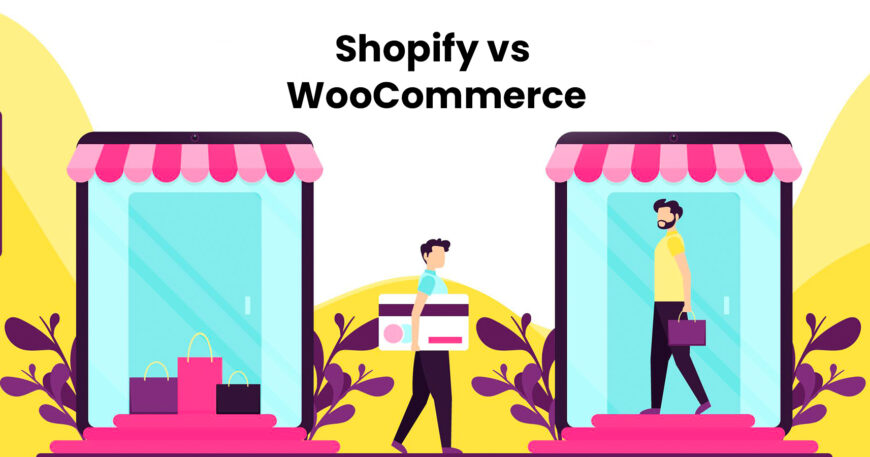In today’s digital age, having an online presence is crucial for businesses to thrive. One of the essential aspects of setting up an online store is choosing the right e-commerce platform. With so many options available, it can take time to decide between them. Currently, two of the most popular e-commerce platforms are Shopify and WooCommerce.
Shopify and WooCommerce are both excellent platforms for setting up an online store. However, each has features and pricing plans that may suit some businesses better. In 2023, companies must be aware of the latest updates and changes to make informed decisions.
If you’re a business owner looking to set up an online store, choosing the right e-commerce platform is crucial. To make this decision, you must have a detailed breakdown of the pricing plans and features available on each platform. In this article, we will comprehensively compare Shopify vs WooCommerce to help you decide which e-commerce platform fits your business in 2023.
Shopify Vs WooCommerce
Before we dive into a detailed comparison of the two most popular eCommerce platforms on the internet, it’s essential to cover the basics and highlight what makes each platform unique. Read on!
Shopify as Your Ecommerce Solution
Shopify store development is an excellent choice for those who want an all-in-one eCommerce solution. This platform allows you to create an online store, collect payments, and manage your inventory from a single, easy-to-use platform. With the help of Shopify development companies, you can manage your eCommerce site without worrying about technical issues such as web hosting, security, caching, and more.
Woocommerce: Your Open-Source Ecommerce Plugin
If you’re looking for an eCommerce solution that utilizes the most powerful content management system available, then WooCommerce might be the best option for you. As an open-source eCommerce plugin for WordPress, WooCommerce allows you to harness the power of the most popular website builder on the planet, which powers a staggering 43% of all websites.
One of the advantages of using WooCommerce is its flexibility. As an open-source platform, you can easily add custom extensions and modify any business element to suit your needs. This makes WooCommerce development a great option for businesses of all sizes, from small startups to large enterprises.
Shopify vs. WooCommerce Price
Cost is frequently the most crucial factor for proprietors of eCommerce websites. You must assess the startup costs while considering the varying costs for additional services and software.
Shopify Pricing
Shopify is a popular platform for creating an online store, and the store development process using Shopify is straightforward. There are different plans to choose from, depending on your business requirements and budget.
The basic entry-level plan costs $39 per month and includes unlimited items, two user accounts, unrestricted file storage, and more. Upgrading to the Shopify plan for $105 per month or the Advanced Shopify plan for $399 per month offers additional features such as lower transaction fees, more staff accounts, and advanced reporting.
When using Shopify, your site will be hosted and come with an SSL certificate. However, the domain name will include the Shopify brand, such as https://your-store.myshopify.com. To utilize your own.com domain name, you must purchase it individually, which costs $14 per year to register.
Additional third-party tools and add-ons may be required to advance your Shopify store development beyond the basic plan. These expenses can add up as your business grows.
In terms of payments, Shopify offers its payment product with a fee of 2.9% plus 30 cents for each transaction. However, if you use third-party payment gateways or your merchant account, you will be charged a higher fee of 2.0% for all transactions. Upgrading to the Shopify Advanced plan can lower this price to 0.5%.
If you’re just getting started, Shopify’s payment solution costs are comparable to other well-known services like Stripe and Braintree.
Additionally, Shopify offers a $7.00/month plan called the Shopify Starter Plan. With this package, you can use Shopify to make in-person sales in some areas or add buy buttons to any website.
If you’re creating a WordPress website, you could add Shopify buy buttons. However, hiring WooCommerce developers can provide a much better experience for your customers.
WooCommerce Pricing
WooCommerce is an e-commerce plugin for self-hosted WordPress websites, and it is free and open-source. To launch a WooCommerce store, you’ll need a domain name, an SSL certificate, and a WordPress hosting account. The cost of a domain name is typically $14.99, and an SSL certificate costs $69.99, while the monthly cost of web hosting is around $7.99.
While this cost may seem high, it’s important to note that several hosting providers offer customized WooCommerce hosting plans at considerably lower prices. This makes launching a primary WooCommerce store much less expensive than starting a Shopify store. Additionally, WooCommerce development won’t tax your purchases in any way, which is a great benefit.
However, it’s essential to remember that as you purchase paid extensions, the cost of WooCommerce development may rise. As your online store expands, so will your hosting expenses.
One of the benefits of using WooCommerce is that you can frequently find free alternatives to premium themes and pricey add-ons. By investing in the tools and plugins you need, you can also keep your expenses under control. With so many free themes and add-ons, WooCommerce is unquestionably the most affordable option.
Shopify Vs. Woocommerce’s Ease of Use
Most people opening an online store need web developers or designers. Even people who are aware of the fundamentals require a platform that is simple to use and stays out of the way.
Examine the user-friendliness of Shopify vs WooCommerce in comparison.
Shopify – Usability
Shopify Agency eliminates software management or installation requirements as a wholly hosted platform. You don’t have to worry about performance, backups, security, or compatibility problems.
You can select a design from various free Shopify themes when you sign up. Then they help you add products after guiding you through customization. Shopify store development has a user-friendly drag-and-drop interface. Within Shopify, managing your product pages, sales, and inventory is simple.
This guided, flawless, and highly optimized user experience has the drawback of limiting your control. You cannot use Shopify’s provided design and development tools or add-ons from their marketplace. But things are better than they seem. The vast array of extensions and themes that Shopify offers should be sufficient for most users to launch and expand their online store.
WooCommerce – Usability
Unlike Shopify, WooCommerce is not a hosted platform. This calls for the installation of the WooCommerce development plugin, the management of updates, the preservation of backups, and the assurance of the safety of your website. Numerous free and premium plugins can automate most of these chores for you.
WooCommerce development offers tremendous customization flexibility. The entire platform is entirely under your control. With more than 59,000 WordPress plugins, you can add any functionality imaginable to your website.
However, there isn’t a drag-and-drop design builder included. Utilizing a WordPress page builder like Beaver Builder or SeedProd will increase your costs.
The flexibility’s major drawback is that it has a learning curve and necessitates more active website management.
Additionally, you must register for a merchant account or a service comparable to Stripe or PayPal.
Even if the WooCommerce-assisted setup wizard is helpful, Shopify’s onboarding process and simplicity of use far outweigh its own.
Choosing Between Woocommerce And Shopify: Which is The Best?
Both Shopify and WooCommerce are effective platforms for launching your online store. It depends on your unique preferences and skill set.
- Shopify store development is much simpler. You don’t need to install anything, and you can start working immediately. Payment arrangements are more straightforward, and their pricing schemes are explicit.
- Shopify’s drawback is that you need to have complete control over everything. With transaction fees, add-ons, and integrations, your prices may increase significantly. Select plans are the only ones you may upgrade to, and pay-as-you-grow billing is not an option.
- WooCommerce development gives you complete control over your website and is open-source. With these WooCommerce hosting companies, opening an online store with WooCommerce is significantly less expensive.
- The drawback is that you’ll have to keep the program updated. There is a slight learning curve involved. Millions of beginners already use it, though, and they breeze through the initial learning curve.
- WooCommerce is the finest platform for you if you’re seeking an affordable solution and want complete control over your online business.
- Meanwhile, Shopify is an excellent platform if you want something that is entirely hassle-free and offers endless scalability.
Wrapping Up
When choosing between Shopify vs WooCommerce, it ultimately depends on your business’s needs, goals, and budget. Both platforms provide pricing plans and feature to suit different business types and sizes.
Shopify is an excellent option for beginners or those who want an all-in-one solution with easy setup and management. At the same time, WooCommerce development is more flexible and customizable for those with more technical know-how.
Overall, it’s essential to carefully evaluate your options and choose the platform that best aligns with your business goals and budget. With the right platform, you can build and grow a successful online store that meets your needs and exceeds your expectations.





